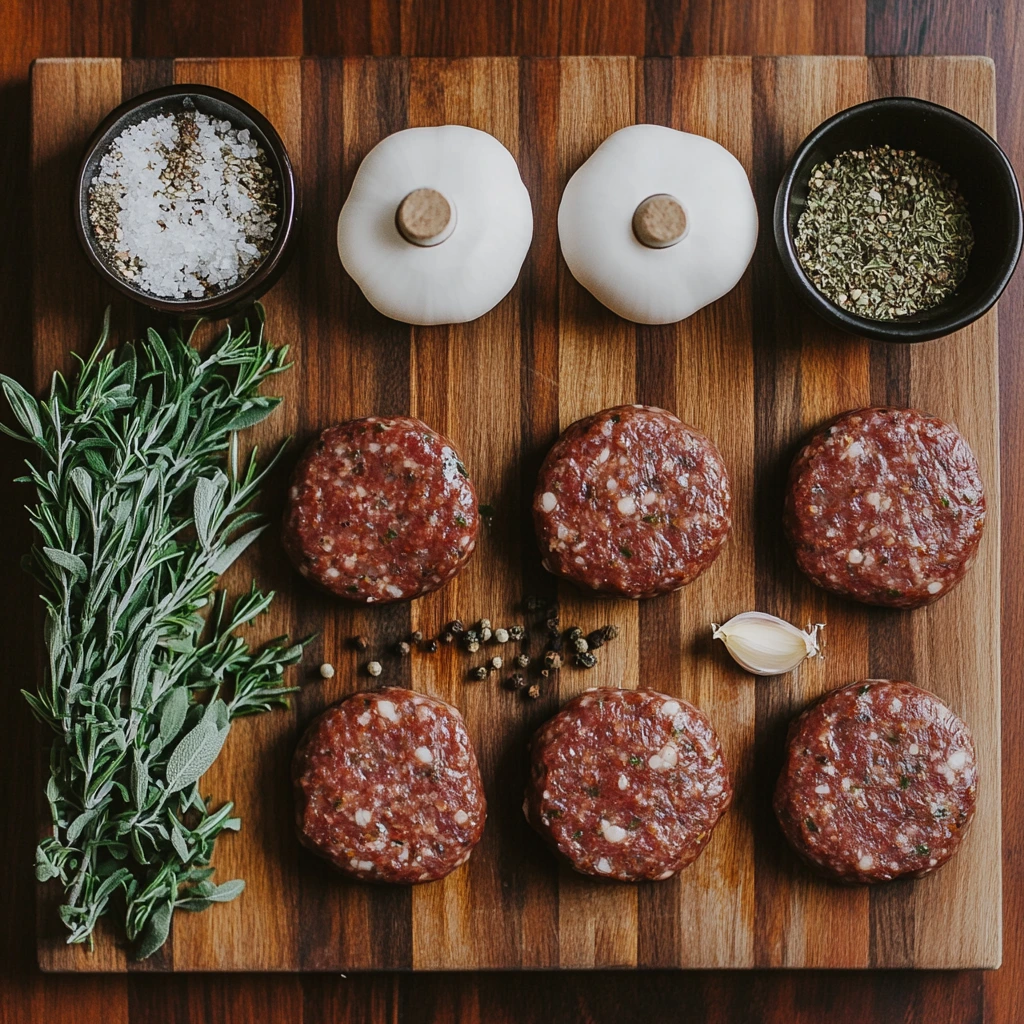Breakfast sausage is a morning favorite for many, offering a savory and satisfying start to the day. But have you ever wondered what gives it that distinctive flavor that separates it from other types of sausages? Let’s dive into the history, key ingredients, and secrets that make breakfast sausage so special.
The History of Breakfast Sausage
Sausage-making is an ancient practice, dating back thousands of years. While breakfast sausage as we know it today is a relatively modern creation, its roots are steeped in culinary tradition.

Sausage in Ancient Times
Historically, sausages were a practical way to preserve meat and utilize every part of an animal. Ancient cultures, from the Romans to the Chinese, experimented with grinding meat and mixing it with spices to create flavorful links. These recipes varied widely depending on available ingredients and regional tastes.
Transition to Modern Breakfast Sausage
The breakfast sausage we enjoy today is largely a product of European colonization, particularly influenced by British and German sausage recipes. Settlers in North America adapted traditional sausages to include local ingredients, eventually creating the sweet and savory flavor profile that’s now synonymous with breakfast.
Key Ingredients in Breakfast Sausage
The magic of breakfast sausage lies in its ingredients. Each component plays a vital role in achieving that unmistakable flavor.
The Role of Pork and Other Meats
Traditionally, breakfast sausage is made from pork. Pork’s natural fat content and mild flavor provide the perfect canvas for seasoning. However, modern variations may include chicken, turkey, or plant-based alternatives for those with dietary preferences.
Seasoning Mix: The Heart of the Flavor
The seasoning blend is what makes breakfast sausage stand out. Common spices include:
- Sage: The herbaceous backbone of the flavor profile.
- Thyme: Adds a subtle earthiness.
- Black Pepper and White Pepper: Provide a warm, spicy kick.
- Nutmeg: A hint of sweetness that balances the savory spices.
Sweeteners and Fillers
Breakfast sausage often features a touch of sweetness to balance the spices. Maple syrup, brown sugar, or honey are popular choices. Some recipes also incorporate breadcrumbs or powdered milk to enhance the sausage’s texture and juiciness.
What Sets Breakfast Sausage Apart
So, what truly makes breakfast sausage unique compared to other types?
The Signature Blend of Spices
While Italian sausages lean heavily on fennel and garlic, and chorizo boasts smoky paprika and chili, breakfast sausage strikes a delicate balance of sweet and savory. The combination of sage, thyme, and a touch of sugar is what gives it that comforting, homey taste.
Mild vs. Spicy Breakfast Sausage
Personal preferences and regional differences influence the flavor profile. In some areas, breakfast sausage comes with a spicy kick, featuring cayenne or red pepper flakes. In others, it remains mild and sweet, perfect for pairing with pancakes or eggs.
Techniques to Enhance Sausage Flavor
How the sausage is prepared can significantly impact its taste and texture.
Grinding and Mixing
The grind of the meat is crucial. A coarse grind ensures a hearty texture, while thorough mixing helps evenly distribute the spices, ensuring consistent flavor in every bite.
Smoking and Curing
Some breakfast sausages undergo smoking or curing processes, adding a depth of flavor. Hickory or applewood smoking imparts a subtle smokiness that complements the spices beautifully.
Cooking Methods
The final preparation—whether pan-fried, grilled, or baked—also makes a difference. A crispy, golden-brown crust enhances the sausage’s natural flavors and provides a satisfying contrast to its tender interior.
🍳 Pro Tip: When cooking breakfast sausage, try deglazing the pan with a splash of water or broth to create a rich sauce that pairs perfectly with your breakfast spread.
The Essential Ingredients and Flavor Profiles of Breakfast Sausage
Now that we’ve covered the history and techniques, it’s time to explore the heart of breakfast sausage: its ingredients and flavor. Every spice, herb, and sweetener works in harmony to create the comforting, distinctive taste we all know and love.
Key Ingredients That Define Breakfast Sausage
The Meat Base: More Than Just Pork
Pork is the traditional choice for breakfast sausage because of its rich fat content and mild flavor. However, modern consumers have expanded the options:
- Chicken and Turkey: Leaner alternatives that are equally delicious when paired with the right seasonings.
- Beef: Offers a bolder flavor, often combined with pork for balance.
- Plant-Based Options: Thanks to advancements in food science, plant-based sausage can replicate the texture and flavor of meat using soy, pea protein, or jackfruit.
The Seasoning Stars: Herbs and Spices
The true magic of breakfast sausage lies in its seasoning blend. Here’s a breakdown of the most important ingredients:
| Spice/Herb | Flavor Contribution |
|---|---|
| Sage | Adds an earthy, slightly peppery flavor that’s quintessential. |
| Thyme | Provides a fresh, slightly floral undertone. |
| Black Pepper | Brings warmth and depth without overpowering. |
| Nutmeg | A sweet and nutty aroma that rounds out the spice mix. |
| Salt | Enhances all the other flavors, making them pop. |
| Red Pepper Flakes (optional) | Adds a subtle heat for those who like a spicy kick. |
Sweetness: The Surprising Element
A touch of sweetness is what sets breakfast sausage apart from other types. Options include:
- Maple Syrup: A classic addition for a sweet, smoky note.
- Brown Sugar: Provides caramel-like richness.
- Honey: A lighter, floral sweetness.
The sweetness balances the savory spices, making breakfast sausage the ideal companion for pancakes, waffles, or biscuits.
What Makes Breakfast Sausage Different from Other Types?
While sausages like Italian or bratwurst are delicious in their own right, breakfast sausage has a unique identity:
- Simpler Ingredients: Unlike heavily spiced varieties like chorizo, breakfast sausage relies on a minimal but impactful seasoning mix.
- Texture: Breakfast sausage is often ground more finely, giving it a smoother bite.
- Cooking Style: Typically cooked fresh, without curing or fermenting, for a milder taste.
Mastering the Flavor: Techniques and Tips
Grinding and Mixing Like a Pro
Whether you’re buying premade sausage or making your own, the grind matters. A medium to fine grind ensures an even texture, while proper mixing ensures every bite has the right balance of spices and fat.
🌟 Insider Tip: Keep your ingredients cold during grinding and mixing to prevent the fat from melting prematurely. This helps maintain a juicy, tender texture.
Cooking Matters: Unlocking the Best Flavor
The way you cook your sausage can enhance its taste:
- Pan-Frying: Creates a crispy exterior while locking in juices.
- Grilling: Adds a smoky element, perfect for outdoor breakfasts.
- Baking: A healthier option that evenly cooks larger batches.
For added flavor, try basting your sausage with a glaze made from maple syrup or honey during the last few minutes of cooking.
Troubleshooting Common Flavor Issues
Even with the right ingredients, achieving the perfect flavor can be tricky. Here’s how to fix common problems:
- Too Bland: Add more salt or spices to bring out the flavors.
- Too Spicy: Counterbalance with a touch of sugar or dairy (like milk powder) to mellow the heat.
- Too Dry: Ensure the meat mixture has enough fat, or add a splash of broth during cooking.
A Closer Look: Sweet vs. Savory Breakfast Sausage
While traditional breakfast sausage leans on the sweet-savory balance, there’s plenty of room for customization. Sweet sausages pair wonderfully with syrupy pancakes, while savory or spicy varieties can complement egg dishes or breakfast burritos.
📝 Fun Fact: Regional preferences play a big role. In the southern U.S., spicier sausages are popular, while northern regions often favor sweeter versions.
💡 Quick Recipe Hack: Want a versatile breakfast sausage? Start with a mild base and divide the mixture. Add extra spices or sweeteners to each portion to suit different tastes.
DIY Breakfast Sausage Recipe
If you’ve ever wanted to create that irresistible breakfast sausage flavor at home, you’re in luck! Making your own breakfast sausage is surprisingly simple and allows you to customize the taste to your liking. Plus, it’s a fantastic way to ensure fresh, high-quality ingredients.

Ingredients List
The foundation of any great sausage starts with the right ingredients. Here’s what you’ll need:
| Ingredient | Quantity |
|---|---|
| Ground pork (or substitute) | 1 pound |
| Sage (dried) | 2 teaspoons |
| Thyme (dried) | 1 teaspoon |
| Black pepper (ground) | 1 teaspoon |
| Salt | 1 teaspoon |
| Nutmeg (ground) | ¼ teaspoon |
| Brown sugar (or maple syrup) | 1 tablespoon |
| Red pepper flakes (optional) | ½ teaspoon |
| Olive oil or butter (for frying) | As needed |
🍽 Nutrition Facts per Serving (2 Patties):
- Calories: ~180
- Protein: 12g
- Fat: 14g
- Carbohydrates: 1g
Step-by-Step Instructions
Let’s break down the process of crafting your own breakfast sausage:
- Prepare the Meat Mixture
In a large mixing bowl, combine the ground pork with all the seasonings and sweeteners. Mix well using your hands or a spatula to ensure the spices are evenly distributed.Tip: For a more intense flavor, let the mixture rest in the refrigerator for at least 30 minutes before cooking.
- Shape the Patties
Divide the mixture into 8-10 portions and shape them into small, flat patties. This ensures they cook evenly. - Cook to Perfection
Heat a skillet over medium heat and add a drizzle of olive oil or a pat of butter. Cook the patties for about 3-4 minutes per side, or until they are golden brown and fully cooked (internal temperature of 160°F).Block Quote:
“Cooking your sausage slowly over medium heat ensures a juicy inside and crispy outside—perfection on a plate!” - Serve and Enjoy
Pair your homemade sausage with scrambled eggs, pancakes, or even a breakfast sandwich. You can also freeze cooked patties for up to a month for quick, delicious breakfasts.
Healthier Alternatives and Adjustments
For those looking to adjust their breakfast sausage recipe to meet specific dietary needs, here are some simple swaps and tips:
Low-Sodium Option
Reduce the amount of salt by half and enhance the flavor with garlic powder or onion powder.
Lower-Fat Version
Use ground turkey or chicken instead of pork. Add a small amount of olive oil to keep the mixture moist.
Vegetarian and Vegan Sausage
Replace the meat with plant-based protein like textured vegetable protein (TVP) or mashed chickpeas. Use nutritional yeast and liquid smoke to mimic the savory, smoky notes of traditional sausage.
Common Issues in Sausage Making
Even the best cooks encounter a hiccup or two. Here’s how to troubleshoot some common problems:
- Too Dry? Add a tablespoon of olive oil or an extra egg yolk to the mixture.
- Too Bland? Increase the seasoning slightly, focusing on sage and thyme.
- Falling Apart? Mix the meat thoroughly to create a stickier texture that holds together during cooking.
🌟 Pro Tip: Freeze individual patties on a baking sheet before storing them in a bag. This prevents them from sticking together and makes reheating a breeze!
Healthier Alternatives and Adjustments for Breakfast Sausage
Breakfast sausage doesn’t have to be an indulgence that you feel guilty about. With a few tweaks, you can enjoy all the delicious flavors of breakfast sausage while sticking to your dietary goals. Let’s explore healthier options, including low-sodium, low-fat, and plant-based alternatives.
Low-Sodium Breakfast Sausage
Many store-bought sausages are packed with salt, but reducing sodium doesn’t mean sacrificing flavor.
Tips for Lowering Sodium
- Use Fresh Herbs and Spices: Sage, thyme, garlic powder, and black pepper can create a robust flavor without the need for extra salt.
- Add Umami: Ingredients like nutritional yeast or a splash of low-sodium soy sauce can mimic the savory depth of salt.
- Homemade Broth: If using a filler like breadcrumbs, soak them in homemade unsalted chicken broth for an extra punch of flavor.
🍴 Example Recipe Tweak:
For a low-sodium sausage, cut the salt by half and double the herbs. Adding a touch of lemon zest can brighten the flavors and make them pop!
Low-Fat Breakfast Sausage
Reducing fat doesn’t mean you have to compromise on taste. Here’s how you can keep your sausage juicy and flavorful:
Use Lean Meats
Ground turkey, chicken, or even lean pork cuts are great alternatives to traditional high-fat pork. However, these leaner options need a little help to maintain moisture.
Keep It Juicy
- Add Olive Oil: A tablespoon or two of olive oil keeps the sausage from drying out.
- Include a Binder: Mix in an egg white or a small amount of Greek yogurt to retain the juiciness.
- Moisture-Rich Ingredients: Try grated zucchini, carrots, or apples for a natural moisture boost.
🌟 Pro Tip: When cooking lean sausages, lower the heat slightly and cook them longer to avoid overcooking and drying out the patties.
Plant-Based and Vegan Breakfast Sausage
Vegetarians and vegans don’t have to miss out on the sausage experience. Plant-based options can deliver similar textures and flavors with a few clever ingredient swaps.
Base Ingredients for Vegan Sausage
- Textured Vegetable Protein (TVP): Provides a crumbly, meaty texture.
- Chickpeas or Lentils: Mashed legumes are great for binding and adding bulk.
- Seitan or Tofu: These protein-rich bases can mimic the chewiness of meat.
Flavoring the Vegan Way
- Liquid Smoke: Adds a smoky depth to mimic smoked meats.
- Nutritional Yeast: Delivers umami richness.
- Herbs and Spices: Stick to the classic sage, thyme, and nutmeg combination.
Balancing Sweet and Savory
One of the hallmarks of breakfast sausage is its delicate balance between sweet and savory. Here’s how to master it, no matter what ingredients you use:
For a Sweeter Sausage
- Add maple syrup, honey, or even apple juice to the mix.
- Incorporate sweet spices like cinnamon or cloves for a unique twist.
For a More Savory Sausage
- Focus on garlic, onion, and a touch of smoked paprika.
- Reduce or omit sweeteners altogether and lean into black pepper and chili flakes.
Common Problems and Solutions
Balancing flavor can be tricky. Here’s how to solve some typical flavoring issues:
- Too Sweet? Add a pinch of salt or extra black pepper to counteract the sweetness.
- Too Spicy? Stir in a bit of cream or Greek yogurt to mellow out the heat.
- Lacking Depth? A splash of balsamic vinegar or Worcestershire sauce can bring out richer flavors.
🍳 Block Quote:
“Eating healthier doesn’t mean giving up your favorite flavors. It’s all about finding the right balance that works for your taste buds and lifestyle.”
Unlocking the Secrets of Breakfast Sausage Flavor
We’ve explored the ingredients, techniques, and even healthy alternatives to breakfast sausage. Now, let’s wrap things up with some frequently asked questions and a recap of what makes breakfast sausage so delicious.
FAQs About Breakfast Sausage
Q1: What makes breakfast sausage taste different from other sausages?
A: The unique seasoning blend, which typically includes sage, thyme, nutmeg, and a touch of sweetness, gives breakfast sausage its distinctive flavor. It also has a milder spice profile compared to varieties like chorizo or Italian sausage.
Q2: Can I use other meats besides pork?
A: Absolutely! Ground chicken, turkey, and even beef can work as substitutes. Keep in mind that leaner meats may need added fat or moisture to maintain juiciness.
Q3: Why does some breakfast sausage taste sweet?
A: Sweeteners like maple syrup, honey, or brown sugar are often added to balance the savory spices. This sweet-savory combination is a hallmark of many breakfast sausage recipes.
Q4: How can I tell if my breakfast sausage is cooked properly?
A: Use a meat thermometer to ensure the internal temperature reaches 160°F (71°C). Additionally, the patties should be golden brown on the outside and no longer pink inside.
Q5: Are there vegetarian or vegan options for breakfast sausage?
A: Yes! Plant-based sausages made with ingredients like chickpeas, lentils, or textured vegetable protein (TVP) can replicate the taste and texture of traditional sausage.
Conclusion: The Secret Behind the Flavor
Breakfast sausage is more than just a side dish; it’s a comforting, flavorful experience that embodies the perfect balance of spices, sweetness, and savory richness. Whether you prefer the traditional pork variety, a leaner option, or a plant-based alternative, the magic lies in the carefully crafted seasoning blend and preparation techniques.

